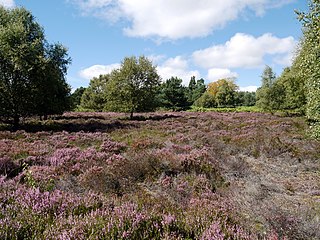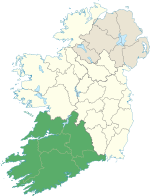
The Silvermine Mountains or Silvermines Mountains are a mountain range in County Tipperary, Ireland. The highest peak of the range is Keeper Hill or Slievekimalta at 694 metres (2,277 ft) high. Traditionally, the mountains were deemed to be part of the Slieve Felim Mountains.

The Wicklow Way is a 131-kilometre (81-mile) long-distance trail that crosses the Wicklow Mountains in Ireland. It runs from Marlay Park in the southern suburbs of Dublin through County Wicklow and ends in the village of Clonegal in County Carlow. It is designated as a National Waymarked Trail by the Irish Sports Council and is waymarked by posts with a yellow "walking man" symbol and a directional arrow. Typically completed in 5–7 days, it is one of the busiest of Ireland's National Waymarked Trails, with up to 24,000 people a year walking the most popular sections. The Way is also used regularly by a number of mountain running competitions.
Ballynahone Bog is a raised bog, situated in County Londonderry, Northern Ireland, about 3 km south of Maghera, on low-lying ground immediately north of the Moyola River about 14 km from its mouth at Lough Neagh. It is one of the largest lowland raised bogs in Northern Ireland.
The Mullaghareirk Mountains is a range of hills in Ireland on the borders of County Cork, County Kerry and County Limerick. The area is also known as Sliabh Luachra. The highest point is Baraveha at 451 metres (1,480 ft). It is bordered by the Blackwater valley to the south, Castleisland to the west, Athea to the north and the Deel valley to the east. Villages in the hills include Rockchapel, Ballydesmond, Brosna, Gneevgullia, Mountcollins, Newmarket, Meelin and Tournafulla. The Allaughaun River, a tributary of the River Feale, rises at the east end of the range.

The Caha Mountains are a range of low sandstone mountains on the Beara peninsula in south-west County Cork, Ireland. The highest peak is Hungry Hill, at 685 m (2,247 ft). Other notable peaks include Knocknagree, Sugarloaf Mountain, Eskatarriff, Knocknaveacal, Derryclancy, Nareera, Killane Mountain and Baurearagh Mountain.

Lambert's Castle is an Iron Age hillfort in the county of Dorset in southwest England. Since 1981 it has been designated as a Site of Special Scientific Interest (SSSI) on account of its geology, archaeology and ecology. The hillfort is designated a scheduled monument together with a bowl barrow, the sites of a post-medieval fair and a telegraph station. The site was on the Heritage at Risk Register but was removed in 2022 as a result of the Hillforts and Habitats Project.

Ballinahown, also spelled Ballynahown, is a village in County Westmeath on the N62 regional road in Ireland. It is 10 km (6.2 mi) south of Athlone and 5 km (3.1 mi) east of the River Shannon. It contains the Roman Catholic St. Colmcilles Church, completed in 1902 to a design in the Early English Gothic-style by William Hague.

Keeper Hill or Slievekimalta is a mountain with a height of 694 metres (2,277 ft) in the Silvermine Mountains of County Tipperary, Ireland. Traditionally, it was deemed to be part of the Slieve Felim Mountains.
Seefin is the anglicisation of the Irish Suí Finn, meaning Finn's Seat, and may refer to the following places in Ireland:
Cullahill Mountain is listed as a marilyn hill and a Special Area of Conservation in County Laois, Ireland. Cullahill with an elevation of 313 m (1,027 ft) gives its name to the local townland. It is also called Knockmannon Hill.
Lune Forest is a Site of Special Scientific Interest covering an extensive area of moorland in the Teesdale district of west Durham, England. In the north, where it adjoins the Upper Teesdale and Appleby Fells SSSIs, it extends from Mickle Fell eastward almost as far as Harter Fell, above the hamlet of Thringarth. Its southern limit is marked by the River Balder, upstream from Balderhead Reservoir, where it shares a boundary with Cotherstone Moor SSSI to the south. Grains o' th' Beck Meadows and Close House Mine SSSIs are entirely surrounded by Lune Forest, but do not form part of it.

Pow Hill Bog is a Site of Special Scientific Interest in the Wear Valley district of County Durham, England. It lies alongside Derwent Reservoir, approximately 2 km north-west of the village of Edmundbyers and adjacent to the Edmundbyers Common portion of the Muggleswick, Stanhope and Edmundbyers Commons and Blanchland Moor SSSI.

The Georgenfelder Hochmoor is a raised bog (Hochmoor) in the German Ore Mountains of central Europe, not far from Zinnwald-Georgenfeld. It is part of a larger bog or moor complex, that lies to the south, mainly on the far side of the Germany's national border in the Czech Republic and which, since time immemorial, has been known simply as "The Lake". The Georgenfelder Hochmoor is one of the oldest nature reserves in Saxony.

The Stack's Mountains are a range of hills northeast of Tralee in County Kerry, Ireland. Traditionally they are deemed part of the hilly region known as Sliabh Luachra, which also includes the Mullaghareirk Mountains.

Moylussa is a mountain in the Slieve Bernagh range in western Ireland, and the highest point in County Clare at 532 metres (1,745 ft).
Lough O'Flynn is a freshwater lake in the west of Ireland. It is located in west County Roscommon and is the source of the River Suck.

Allendale Moors is a Site of Special Scientific Interest (SSSI) in Northumberland, England. The upland moorland ridge site is listed for its heath, flush and upland grassland which provide a habitat for a nationally important assemblage of moorland breeding birds.

Bewick and Beanley Moors is the name given to a Site of Special Scientific Interest (SSSI) in north Northumberland, in the north-east of England. The moors are asserted to be of national importance by Natural England for the extent, quality and diversity of upland types including heaths, fens, wet grassland, flushes, mires and blanket bogs, together creating an extensive mosaic habitat supporting an exceptional community of amphibians. The moors are important, too, for their relict juniper woodland and scrub.
Sraheens is a townland and boggy area on the island of Achill, County Mayo, Ireland, to the southwest of Achill Sound. The townland, in the southeastern part of Achill, belongs to the barony of Burrishoole in Achill Parish and has an area of 895.47 hectares. It borders Cashel to the west, Derreen to the south, Dooega to the west and Salia to the north.
The Carrigeenamronety Hill Special Area of Conservation or SAC is a Natura 2000 site in the Ballyhoura Mountains, Ireland. The qualifying interests for which it is protected as an SAC are the presence of the Killarney fern and the presence of a dry heath habitat.















